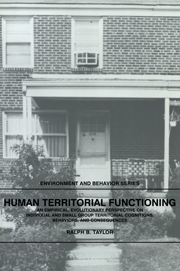 Human Territorial Functioning
Human Territorial Functioning Book contents
- Frontmatter
- Contents
- List of figures, tables, and boxes
- Series foreword
- Preface
- Acknowledgments
- 1 Introduction
- PART I ORIGINS OF HUMAN TERRITORIAL FUNCTIONING
- PART II A CONCEPTUAL MODEL OF HUMAN TERRITORIAL FUNCTIONING
- 5 A perspective on human territorial functioning
- 6 Clarifying psychological and ecological consequences
- PART III TERRITORIAL FUNCTIONING IN SETTINGS OF VARYING CENTRALITY
- PART IV APPLICATIONS TO SOCIAL PROBLEMS
- PART V REVIEW AND PROSPECTS
- Index
6 - Clarifying psychological and ecological consequences
Published online by Cambridge University Press: 05 February 2010
- Frontmatter
- Contents
- List of figures, tables, and boxes
- Series foreword
- Preface
- Acknowledgments
- 1 Introduction
- PART I ORIGINS OF HUMAN TERRITORIAL FUNCTIONING
- PART II A CONCEPTUAL MODEL OF HUMAN TERRITORIAL FUNCTIONING
- 5 A perspective on human territorial functioning
- 6 Clarifying psychological and ecological consequences
- PART III TERRITORIAL FUNCTIONING IN SETTINGS OF VARYING CENTRALITY
- PART IV APPLICATIONS TO SOCIAL PROBLEMS
- PART V REVIEW AND PROSPECTS
- Index
Summary
Streets, boundaries, forecourts, and entrances are key areas for self-expression. All those who enter a house must pass through some forecourt. Creating a good impression, a powerful impression, or a friendly, welcoming one depends very much on this “front.” This area is also very susceptible to pressure from neighbors. A resident who fails to mow the lawn regularly or to paint the house, or who leaves old cars outside will soon incur the ire of neighbors in most communities. It may be property values that people worry about or it may be simply the sense of street identity.
– Don Appleyard, “Home” (1979)The conceptual framework introduced in the preceding chapter associated human territorial functioning with four classes of consequences: social psychological within group, social psychological between group, psychological, and ecological. That framework is more fully specified in the current chapter.
Organization of the chapter
Two additional perspectives are introduced that clarify how the psychological and ecological consequences of territorial functioning, depicted in the preceding chapter, emerge. A context-specific stress model developed by Dan Stokols is outlined. This perspective delineates the process leading to stress-related consequences. It is particularly helpful in considering spaces where the person-place bonds are of high centrality. In relatively private locations, where the person-place bond is of high centrality, territorial functioning accomplishes a spatiotemporal sorting, reducing conflicting functional demands and thereby decreasing experienced stress.
- Type
- Chapter
- Information
- Human Territorial FunctioningAn Empirical, Evolutionary Perspective on Individual and Small Group Territorial Cognitions, Behaviors, and Consequences, pp. 117 - 132Publisher: Cambridge University PressPrint publication year: 1988


